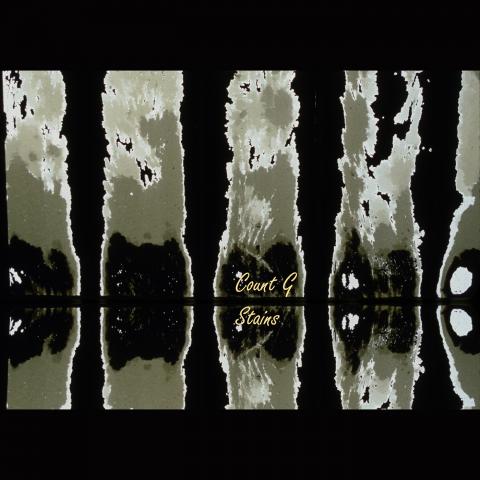Rumor has it that after the dream soundscapes of Pursuing Phantoms Count G disappeared in The Boys Room in order to make his “commercial album”. When he emerged again covered with Stains, he graciously laughed at the idea. Like a little book of musical poems, Stains exhibits much of the idiosyncratic sculpting of sound we’ve come to recognize as Count G’s signature. But it is also a point of departure, even as it references his fondness for weaving rhythmic arrangements with improvisational flights of fancy that we saw in his inaugural Pyramid Coil.
Stains is a study of rhythm in a variety of musical modes, from drum-and-bass to ambient noise or free jazz. Almost all tracks are built upward from drum or percussion foundations. Special attention is given to the interplay between percussive sounds and reed instruments – Count G’s love of reeds goes back to his youthful clarinet improvisations and his formative relation to jazz. Oftentimes, reeds and horns explicitly carry the underlying pulse or work as counter-rhythms; other times they serve as interruptive noise makers or somnambulent backdrops.
Unlike previous records, there is little remixed material here, even as the integration of field recordings remains paramount. Instead, the music allows a lot of room for random developments and improvisational playing alongside constructed rhythms and strict arrangements. Yet, improvised solos are often transposed to tracks other than the ones in which they were generated, perhaps in the way that Frank Zappa called xenochrony. The result is a strange coherence between otherwise disparate musical attitudes, interwoven by organic associations of sound that include their embrace of randomness.
Count G once said that the impetus for Stains was his son’s challenge to write music that he could play for his friends. Success in meeting this challenge can only be narrowly evaluated, but the idea that Count G might be foolish enough to want to make music that can be danced to, while still subverting expectations of how music is conventionally related to dance, may be the most intriguing dimension of this album.
-------------------
released May 5, 2018
CREDITS
Count G – keyboards, drums/percussion tracks, loops, field recordings, voices, piano (1, 12, 14), clarinet (10), dead harmonium (4, 16), tilted bass (17)
Deviant Fond – cosmonaut synth (16)
Remix samples taken from Arseny Avraamov, Erykah Badu, William Basinksi, Lea Bertucci, Christoph De Babalon, Fred Frith, Heiner Goebbels, Robert Normandeau, Sun Ra, Tor5y
“Felucca Fragments (Float on the Nile)” was commissioned by the Fencepost Reclamation Project and is composed around a rhythm track created from the Project's archive of recorded sounds of everyday objects (creaking chairs, coins, rubber bands, glass, or steel machinery). An early mix, without the field recordings from Cairo, can be found at lessthanone.bandcamp.com/album/the-fencepost-reclamation-
The vocal and synth part in “The Meeting Room” was recorded by Deviant Fond at his Sinking Ship studio in Berkeley, CA (November, 2007)
Piano (1) was recorded in Berkeley (November 2015) and (12, 14) in Los Angeles (March 2018)
Dead harmonium was recorded at a Shoreditch flat in London (June 2017) in collusion with Todd Brunner
“Otto’s Mirage” was recorded in Athens on December 18, 2017. Along with “Otto’s Decay” they are both remnants from the aborted oratorio "Otto Ban".
All other recording took place in The Boys Room, Riverside Studios, New York (September 2017 – March 2018). Mastering at Terra Infirma (April 2018).
All compositions, arrangements, and production by Count G, except “The Meeting Room” (Count G/Deviant Fond)
Cover photo and design by Stathis Gourgouris: Soot-stained glass from the London Underground (June 1980)
Stains are scattered by definition, but like poems, these stains mark page by page.
You can find out more about this release and many others at Sublamental Records: https://sublamental.com/count-g/stains
